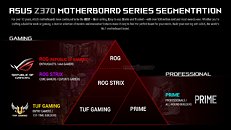Sunday, October 1st 2017

ASUS Motherboard Segmentation Explained - "Prime" Series takes Backseat
With its new Intel 300-series chipset-based motherboard family, ASUS is redoing the segmentation of its various motherboard brands, with the objective of avoiding too many similarly-priced products that bloat the lineup and confuse buyers. The company articulated its segmentation using a triangle (pictured below). At the bottom of this triangle is the mainline "Prime" series, and interestingly, the TUF (The Ultimate Force) series. The TUF series has until now been attributed to moderately expensive motherboards that are designed with very high durability. They are now relegated to the bottom of ASUS' product-stack, targeted at first-time builders and entry-level gamers. These boards are still built "tough" in that they feature high-grade components, but not as many CPU VRM phases as some of ASUS' more expensive boards.
Another revelation is that the company's mainline "Prime" series, which has served as the bedrock of the company's motherboard lineup before sub-brands such as ROG came along, is now entry-mid range, with just two SKUs based on the Z370 chipset. The Prime Z370-A is recommended for those users who want to cut through the marketing clutter and pick a board that maxes out this platform without too many frills. This move also ends the possibility of higher Prime-series SKUs such as "Deluxe" and "Premium," which were previously associated with SKUs bursting at the seams with onboard connectivity options.The "Republic of Gamers" (ROG) brand has a clear sub-division, with boards featuring just the "ROG" moniker next to brands such as Crosshair (AMD MSDT), Maximus (Intel MSDT), Rampage (Intel HEDT), and Zenith (AMD HEDT), making up the upper-end; and the Strix brand making up the upper-mid range bulk. The ROG Crosshair, Maximus, Rampage, and Zenith sub-brands will get extensions such as "Ranger," "Hero," "Formula," "Impact," "Gene," "Extreme," "Code," and "Apex;" while the ROG Strix brand will be sub-divided as Strix-E (topmost), Strix-F (second-best), Strix-G (micro-ATX), Strix-H (entry ATX), and Strix-I (mini-ITX). Some of these SKUs may get the "AC" extension denoting a WLAN module with 802.11ac and Bluetooth 4.x.
Another revelation is that the company's mainline "Prime" series, which has served as the bedrock of the company's motherboard lineup before sub-brands such as ROG came along, is now entry-mid range, with just two SKUs based on the Z370 chipset. The Prime Z370-A is recommended for those users who want to cut through the marketing clutter and pick a board that maxes out this platform without too many frills. This move also ends the possibility of higher Prime-series SKUs such as "Deluxe" and "Premium," which were previously associated with SKUs bursting at the seams with onboard connectivity options.The "Republic of Gamers" (ROG) brand has a clear sub-division, with boards featuring just the "ROG" moniker next to brands such as Crosshair (AMD MSDT), Maximus (Intel MSDT), Rampage (Intel HEDT), and Zenith (AMD HEDT), making up the upper-end; and the Strix brand making up the upper-mid range bulk. The ROG Crosshair, Maximus, Rampage, and Zenith sub-brands will get extensions such as "Ranger," "Hero," "Formula," "Impact," "Gene," "Extreme," "Code," and "Apex;" while the ROG Strix brand will be sub-divided as Strix-E (topmost), Strix-F (second-best), Strix-G (micro-ATX), Strix-H (entry ATX), and Strix-I (mini-ITX). Some of these SKUs may get the "AC" extension denoting a WLAN module with 802.11ac and Bluetooth 4.x.

33 Comments on ASUS Motherboard Segmentation Explained - "Prime" Series takes Backseat
Tuf 990fx was one of the few good amd boards out. :)